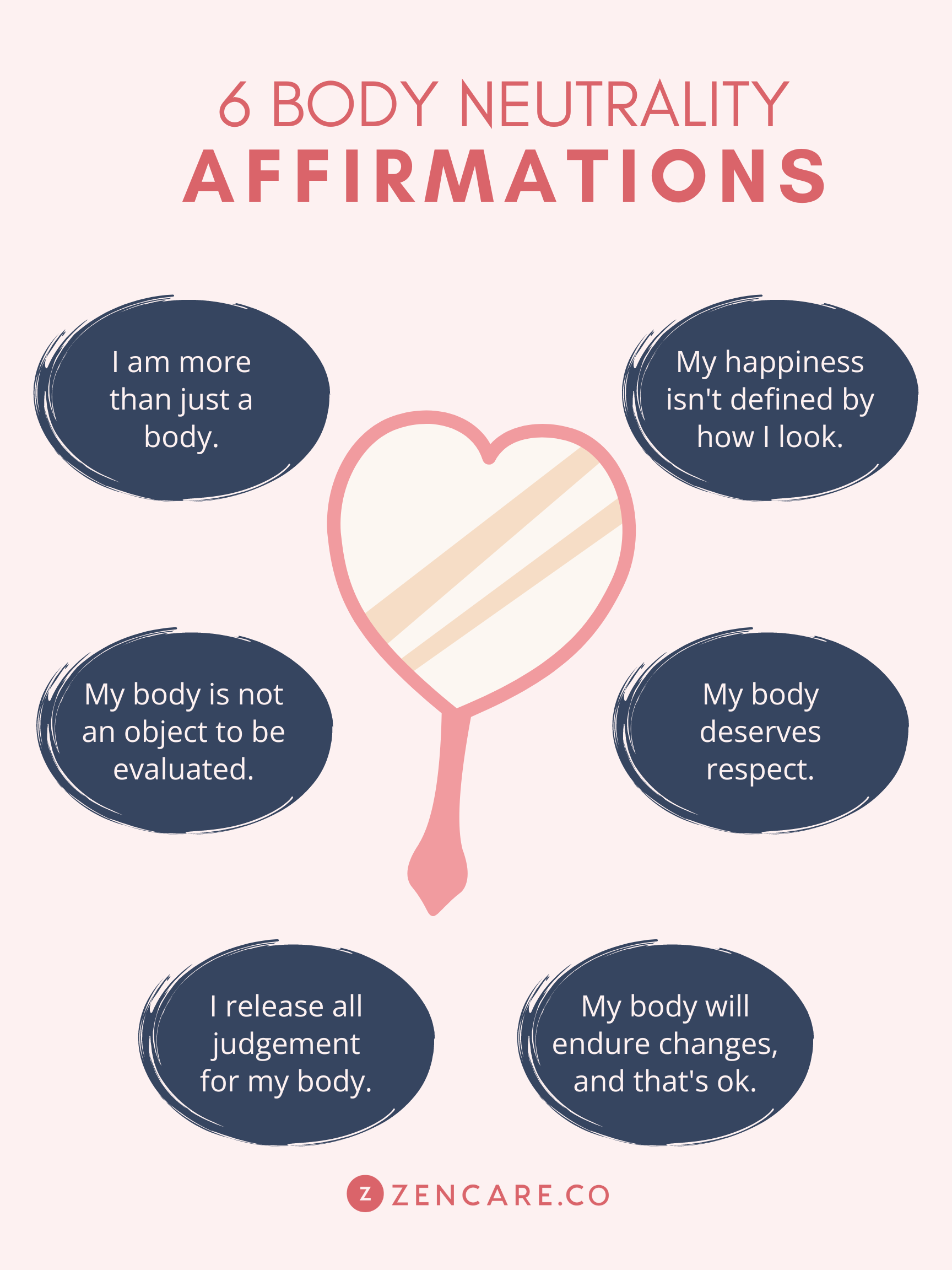In our fast-paced, results-driven, and self-comparing world, it’s easy to fall into the trap of equating “just enough” with “bad.” This is particularly true when it comes to well-being. With so much self-help content out there — the podcasts, the articles, the videos, and more — the messages that we take in can falsely tell us: “If you aren’t thriving, then you aren’t doing well.”
And yet, even if you aren’t thriving, you can still be healthy, happy, and fulfilled. Sometimes, “just enough” is exactly what you need to be to maintain balance and peace in your life. This is especially true when it comes to body image issues. Feeling uncomfortable with sentiments like, “I love my body, no matter what I look like!” can mean that you’re looking for a different concept altogether: body neutrality.

What is body neutrality?
Body neutrality is a concept that centers the mindset on body acceptance. It has more to do with appreciating the body for how it helps you experience the world than how you appear in the mirror.
Bodies can do extraordinary things. They can digest food, take the oxygen out of the air and put it in our bloodstreams. Our brains give us dreams when we sleep and our fingers let us feel the textures of the environment. Bodies can enable us to climb mountains, laugh at a friend’s joke, and do our taxes each year. There are many incredible ways that our bodies facilitate our lives, including the most important elements of living: loving, connecting, and experiencing joy.
Body neutrality acknowledges and salutes our body’s abilities and activities. This concept empowers those who feel down about the appearance of their bodies to focus instead on the ways that their bodies contribute to life experiences. People practicing body neutrality can also appreciate the difficult experiences that their bodies have gone through, including childbirth, the flu, or chronic illness. Body neutrality posits that bodies should be recognized for their capabilities, and that bodies should be seen through this perspective, rather than through an appearance-based perspective.
What is body positivity?
Body positivity, on the other hand, is a concept that focuses on the perpetuation of self-love and celebration of your shape, size, and other appearance-related features. It recognizes that society’s perpetuation of what “healthy” and “attractive” look like are highly problematic, particularly the focus on a type of thinness that is unattainable for the majority of the population. Body positivity throws out the idea that you have to have a certain body shape to be considered “good-looking” and replaces that idea with radical self-love. Rather than loathe your curves, love them. Rather than to despise your freckles, embrace them.
Body positivity has a huge following and is the subject of much health-related discourse. The body positivity movement itself has spanned more than half a century. Many people find the idea of body positivity as empowering, and it’s benefitted many people’s self-esteem.
Body neutrality vs. body positivity
Contemporary well-being discourse focuses on the benefits and downsides of both body neutrality and body positivity. But what is the difference between the two? And what do they look like in action?
We can see how both body neutrality and body positivity play out across a range of situations. Take the example of Mindy, who gave birth to a daughter six months ago. Here are the ways that she could see her body:
- Body neutrality: “I might have stretch marks on my stomach, but that’s okay. I love them because they tell my story.”
- Body positivity: “Wow, I created my daughter from my own body. That’s incredible, she’s perfect — and my body did that. My body is amazing.”
Another example might be Javier, whose job requires him to be on his feet for most of the day. Here’s how he can see his body:
- Body neutrality: “My legs carry me throughout the day, they’re the way that I can afford to pay for the apartment that I share with my partner. I appreciate them so much because of this.”
- Body positivity: “I love that my legs are big. I’ve always enjoyed wearing shorts because they show off my legs.”
A third example is Jamie, who is diagnosed with diabetes. They might think see their body in these ways:
- Body neutrality: “My body might not function like other people’s but that’s okay. It causes me pain sometimes, but it still takes me to school, where I’m writing my dissertation. My body enables me to hang out with my friends and to travel, and for those reasons, it’s a great body.”
- Body positivity: “I love my body despite its challenges. I love my curves and how soft my stomach is. My weight is what keeps me going and I wouldn’t trade it for anything.”
What is the body neutrality movement?
One of the key differences between body neutrality and body positivity is that body neutrality doesn’t focus on appearance. The body neutrality movement was born from the desire to shift mindsets away from appearance. There are many great elements of the body positivity movement, but the focus on appearance detracts from the multiple dimensions that bodies have.
Body neutrality puts forth that our bodies should be celebrated for what they do, rather than how they look. Body neutrality doesn’t mean that you need to believe that your body is perfect — it means that you accept it and respect it for what it is and what it allows you to do with your life.
Should I be body neutral or body positive?
Both body neutrality and body positivity have a seat at the table when it comes to well-being. It’s very much possible to subscribe to both perspectives, or to one perspective at one point in your life and the other at another point. Many people find themselves striving for better self-esteem or striving for a resolution to their body image issues, and they can benefit from learning about both types of thinking.
For all of the critiques of the body positivity movement, there’s a time and place for self-love and compassion. You can celebrate your body and all of its outward features while still respecting and appreciating its internal workings. No one should force you into one camp over the other. What’s best is to follow your intuition as it relates to where you are in life and with your mental health.
How do I practice body neutrality?
To practice body neutrality, start by reflecting on all of the things that you enjoy doing, whether that’s traveling, playing with your dog at the park, reading a good book, having a glass of wine with your partner — whatever brings you joy. Now think about how your body helps you do those things. How does your body work so that you can breathe, stretch, relax? What processes does it go through each day, sometimes without you even noticing? Keep this in mind, especially when you start to doubt your worth because of your body.
Try to avoid any conversations about body shape and appearance. If you find that social media leads to negative thoughts about appearance or body image issues, set limits for yourself — take a break from social media, or look to follow folks who subscribe to the mindset you want to cultivate for yourself. Instead, focus on how you feel. If you feel hungry, celebrate eating. If you’re tired, cherish your sleep and rest and consider how restorative it is.
Lastly, adopt a body neutrality mantra or affirmation that’s meaningful to you. Your body neutrality mantra might be, “I love my body for what it helps me do” or “My body is powerful because it ____.” Say this mantra to yourself throughout the day — it makes a great addition to a gratitude practice.
How can therapy help with body neutrality?
There are many ways that therapy can help you to internalize body neutrality. At its worst, negative body image can lead to disordered eating and body dysmorphia. Therapists can support you to recover from these challenging mental health conditions with a body neutrality perspective. It’s particularly important to connect with an experienced eating disorder therapist when you’re concerned that your behaviors are damaging to your health. Many therapists empower clients by teaching them about the concept of Health at Every Size, which states that individuals can be healthy no matter their weight, as bodies naturally vary.
Conversations with a therapist about body neutrality can be a gateway to speaking about other areas of your life, including trauma experiences, gender and sexuality, and attachment. By talking about body acceptance with your therapist, you might be surprised at what else comes to mind — and your therapist can help you unpack those things too.
Overall, how you embrace your body doesn’t matter so much as whether you do so. When facing body image challenges, body neutrality is a measured way of celebrating your body, and can be a good next step that feels authentic when body positivity feels too hard to achieve. Once you recognize that “enough” is actually a great place to be, that “enough” is exactly what you need to do what you love, then cherishing the vehicle that gets you there is simple.
